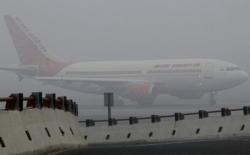
New Delhi, December 25: Dense fog continue to wreak havoc on the operations at the Indira Gandhi International Airport here for the third consecutive day and led to delay of over 100 flights, diversion of seven and cancellation of 10 others.
Schedules of over 100 flights were badly affected after dense fog enveloped the airport late last night and early this morning.
The flights were delayed from half an hour to five hours and some of them had to be cancelled, causing inconvenience to the passengers, airport officials said.
Fog started to descend at the airport around 10 PM yesterday but the runway visibility was fine and flight operations were normal.
But the situation started to deteriorate around 11.21 PM when visibility dropped to 50 metres on the third runway (29/11). However, the visibility was around 800 metres on the main runway (28/10) and, therefore, flight operations went on unhindered on it, they said.
Fog became more dense around 12.30 AM, when the visibility on the main runway also dropped to 50 metres while that on the third runway was below 50 metres, which brought the flight operations to a standstill.
A total of seven (six domestic and one international) flights were diverted to nearby airports like Jaipur, Ahmedabad and others, the officials said. The visibility started to increase after 1.30 AM on the main runway and flights began taking off as and when the conditions were right, they said, adding the flights arriving here were using instrument landing system (ILS).
The visibility at one end of the third runway remained zero till almost 5.30 AM.
A total of 138 domestic and international flights arrived assisted by various category of ILS. 69 flights with CAT-I (when visibility is upto 550 m), 19 flights with CAT-II (when visibility was between 550 and 300 me), 30 flights with CAT-IIIA (when visibility was between 300 and 200 m) and 20 flights with CAT-IIIB (visibility between 200 and 50 m), an airport official said.
Yesterday around 140 flights were affected due to dense fog.
MeT department has predicted that the runway visibility is likely reduce to 500 metres in shallow fog by 11.30 PM and it may further reduce to below 200 metres in dense fog from 3.30 AM tomorrow.





Comments
Add new comment